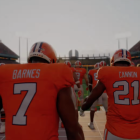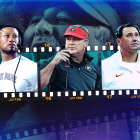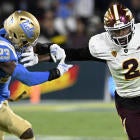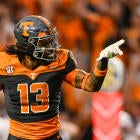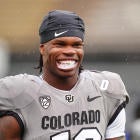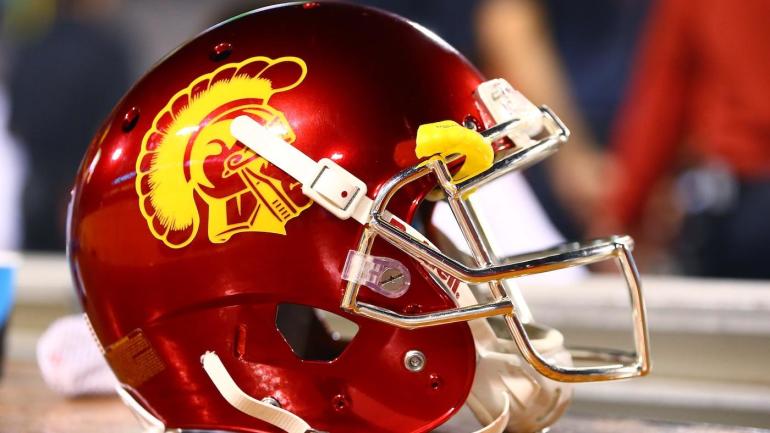
Spencer Harris' phone rang close to midnight. USC's 28-year-old player personnel director was lucky to see the call, he was that tired.
When you're hip-deep in college football recruiting, you never turn in early. And you sure as hell don't sleep on a talent whose commitment was on the other end of the line that night in mid-December.
"Korey is ready to go," Gavin Morris, USC's director of player development, told Harris.
Those five words not only guaranteed the Trojans' best recruiting class in years, they might as well have echoed throughout college football.
"Korey" is Korey Foreman, the No. 1 overall recruit in the Class 2021, according to the 247Sports Composite. The talent oozing from a 6-foot-4, 265-pound defensive end from Corona, California, only begins to tell the story of a possible USC and Pac-12 resurgence while providing a future glimpse of college football littered with the riches available to him.
Back to that phone call. Foreman committed to USC that night, but only a handful of people knew it: Harris, Morris, USC's compliance officer and coach Clay Helton. Foreman intentionally wanted to keep his secret in a small circle, a so-called "silent commitment."
In keeping with why he came to USC in the first place, Foreman wanted to make a splash. Fifteen days after that call, he announced his college choice Jan. 2 during NBC's telecast of the All-American Bowl.
"That was our opportunity to blow him up," Harris said.
USC has done just that in making Foreman the centerpiece of the program's reawakening. It starts in the places where it matters only slightly less that on the field: advertising, marketing campaigns, the mind of the player himself.
An 18-year-old who has yet to play a snap is featured on a pair of billboards near the USC campus.
"It was like I was the King of Hollywood," Foreman told the Los Angeles Times in describing USC's recruiting approach.
You can see where this could head. Any Pac-12 revival almost certainly has to start at USC, which is armed with the No. 8 recruiting class in the 247Sports Composite ahead of the traditional National Signing Day this Wednesday. The Trojans are the Pac-12's flagship program. L.A. is the athletic and cultural center of the league and the West Coast. Pac-12 teams all have to come through there to recruit.
But a trend lingers: The state of the Pac-12 across the board has dropped to unprecedented depths.
Foreman is USC's first No. 1 overall recruit since quarterback Matt Barkley in 2009; he is among 11 USC recruits in 247Sports' top 300, a number that could still grow as Wednesday approaches.
Oregon, ranked sixth nationally, actually leads the conference and is in the top 11 of the 247Sports Composite for the third straight year.
The bottom line continues to be winning on the field. The Pac-12 isn't doing enough of it. The conference continues to have the longest national championship drought among the Power Five conferences. Its last title came in 2004.
It is fitting Foreman has chosen 0 as his number. If a USC turnaround starts with him and this class, symbolically, nada is a good place to begin.
"It starts on the field. You have to produce," Harris said. "But he's already got his [own] logo. He's got some [branded] clothing. He's going to put the time and effort and work into it. He's set himself up to be the next guy."
Under Helton this year, USC made a conscious effort to change its recruiting philosophy. The school partnered with J1S, a Dallas-based creative agency that has taken on only two other FBS programs, Georgia Tech and Oklahoma. Here's a glimpse at the relationship between USC and J1S.
An early hype video produced for USC football was considered so edgy the school ordered it taken down. Part of the video portrayed a Hollywood-like movie premier where the participants weren't wearing masks. USC reportedly took proper COVID-19 testing precautions in making the video.
"It was a bad-ass video," said a person close to the program who saw the finished product. "Even if it got taken down, every single recruit saw it. Every single college football program saw it."
The point is that the likes of Foreman saw it. A combination of the kid's talent, USC's energy and restrictions in place amid the COVID-19 pandemic guided him to the Trojans. Foreman initially decommitted from Clemson. One report stated he was the first recruit of that stature coach Dabo Swinney had lost in five years.
"Then I thought LSU and Georgia were the teams to beat. USC wasn't in his top five until the middle of the season," said Greg Biggins, a 247Sports national recruiting analyst based on the West Coast.
By that time, COVID-19 had intervened in the process. Foreman couldn't go on official visits. Heck, he couldn't even play. High school football wasn't played in Southern California last fall due to the pandemic. Aside from appearing in some offseason showcases, Foreman kept that No. 1 overall ranking despite not playing his final season.
USC cornerbacks coach Donte Williams had developed the strongest relationship with Foreman among those on staff. Williams began recruiting Foreman while at Oregon in 2018 and 2019.
"If this was 10 years ago, [Foreman going to USC] wouldn't even be a question," Williams said. "If this was 10 years ago, he'd probably be committed a year early. It was a huge steppingstone to let everyone know that USC is trying to do everything it possibly can from administration to coaching to everything."
Helton and his creative staff, armed with those J1S videos, kept coming hard on Zoom. When it came time to finally take the field, USC started late playing conference games only, but it started well going 5-0 before losing the Pac-12 Championship Game to Oregon.
"COVID probably saved Clay Helton's job," one West Coast recruiting insider said. "If USC plays Alabama [on the original schedule], they probably lose by 40. They probably lose to Notre Dame by 30. All the sudden the season goes downhill."
Instead taking official visits all over the country, Foreman stayed home to watch first-hand how USC had improved.
"I think if we didn't play in 2020 it would have significantly hurt our chances," Harris said. "I don't think Korey Foreman would have signed with us."
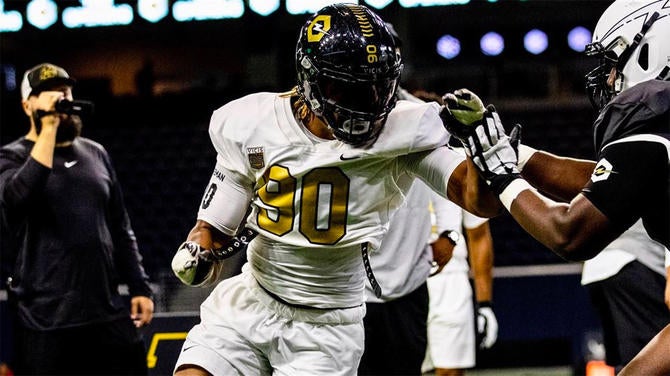
Foreman arrives sort of pre-packaged to have at least some sort of impact. He already has that logo -- "K4" -- to go along with an Instagram and Twitter following. Athlete social media leader Opendorse put his current annual earning power in social media alone at $16,000.
Where better than L.A. to become a star in a different sense while, you know, playing a little football? Name, image and likeness promises to make it more lucrative for college players. NCAA legislation allowing players to profit off their accomplishments both on the field and off is expected later this year. Foreman will be a freshman in the first year the NCAA allows players to be compensated for their social media following, endorsements, autographs and commercials.
"The whole world is about to turned upside down in that sport," said Michael Jones, CEO of J1S. "It's going to be fun to look back here in five years and see how it looks."
It's fun watching now as schools scramble to fit whatever NIL looks like. USC isn't the only program to develop entire arms of their recruiting departments around NIL. This athletic, recruiting and marketing comeback makes USC a bit of a huggable underdog. Harris started as an equipment manager at Washington before being promoted to player personnel director under Chris Petersen. He joined USC in April 2019.
Jones is a former Southern Miss receiver who played under Todd Monken. An injury forced him into recruiting while still in school. His star rose in a similar recruiting role with Kevin Sumlin at Texas A&M. The St. Louis native fell in love with USC when his father took him to see the Trojans play in the 2007 Rose Bowl against Michigan.
"Our job is to make USC the biggest brand it can possibly be," Jones said. "Korey is clearly going to be seen as one of those kids seen across the country. Not only because of his talent but because where he decided to go and play. We can debate all day, but there is no school bigger in the Pac-12 than USC."
There may be no school in the Pac-12 that longs harder to be nationally relevant again. If only because USC is so used to success and so wounded by not having it.
"When I talk to schools, I tell them Hilton Hotels had no business losing being the No. 1 hospitality provider in the world," Jones added. "It was because they didn't take a fast enough approach when Airbnb started coming. Ford should not be looking at Tesla saying, 'How do we ever catch them?' A lot of times, these programs that have sat on their tradition and sat in the driver's seat for so long, they're naïve to big industry changes."
How schools react to those changes will define the game going forward. The likes of Alabama, Clemson and Ohio State have separated themselves because they are the best at everything: recruiting, coaching, facilities, nutrition. Soon, they will control the NIL space, too.
None of them can offer what the likes of USC and UCLA can in L.A. -- if only the football follows.
Baby steps, then, for USC and its wounded tradition.
In 2020, Trojan players themselves may be largely responsible for a season being played out West. Foreman's former high school teammate, Drake Jackson, had an effective sophomore season on the USC defensive line. Helton has raised his profile winning the Pac-12 South for the second time in four years and maybe -- maybe -- the hearts of some USC fans who previously had brutalized him.
USC is in the top 10, a year after finishing No. 64 in the 247Sports Composite team rankings. Helton made sure more recruiting support staff were added to concentrate on creative strategies. A production arm of J1S, BLVD Studios, pushed out a hype video a week during the season.
"The recruiting process isn't about a recruiting trip anymore or the best club they can take you to or meeting a girl," said Jordan Campbell, who trains Foreman and played for USC from 2007-09. "Now, it's really having time to do your due diligence and do these Zoom meetings. That really helps USC out to help recruit these kids."
On Jan. 2, not even USC defensive coordinator Todd Orlando or defensive line coach Victor So'oto knew Foreman had committed. During that All-American Bowl, Williams was climbing the walls. His recruiting prize had gone dark.
"We had created a relationship that was far beyond football," Williams said. "Korey wanted to make sure that it was a state of shock for me that he was even coming to USC."
What's next, shocking the world?
There was a time when Reggie Bush and Matt Leinart didn't -- or at least weren't supposed to -- earn a dime from their fame. However, during their run 15 years ago, they owned the city in an emotional sense. When USC is rolling, it is like a professional franchise. It captures the sports heart of L.A.
NIL will put a dollar figure on that fame. Bush's NIL earning power would have been $4 million or more had NIL rules been in place during his playing days, a story in The Athletic estimated in 2020.
"It could be very lucrative," Jones said. "I don't think it's out of the realm of possibility for players like Korey who stay in their home cities or stay on the West Coast or come to the big city of L.A., you can make those type of figures before you leave."
Jones says only the top 1-2% will earn huge NIL money, but the basic questions from recruits have changed: How are you going to get me to the NFL, and how much money are going to make me on my way there?
Jones wants to approach NIL the way apparel makers approach schools: creating an elite set of schools that offer unique branding the way Nike and Adidas face off with each other in recruiting. That happened prior to the 2011 BCS Championship Game, the first ever title game between a Nike school (Oregon) and an Under Armour school (Auburn).
Jones calls this "The Jordan Approach." If programs can be known as "Nike schools" stamped with Michael Jordan's Jumpman logo, they can also be branded with J1S.
"If kids are looking at it from a standpoint, 'Hey I want to be at a Nike school,'" Jones said. "We want them to say, 'I want to be at a J1S school.' We're the premier offering in that space."
In the future, recruiting battles may be further defined by brands, not necessarily apparel companies. Jones says Pittsburgh will become a battleground city more or less equidistant between Ohio State and Penn State. An advertiser will have a tough choice to make.
"Is it smarter for me to have the starting quarterback at Ohio State [on a billboard] in Pittsburgh or the starting quarterback at Penn State?" Jones said.
If the Pac-12 is going turn around, it has to embrace those long-term visions. But nothing turns around until its flagship program becomes a destination again.
Rival schools east of the Rockies have scoured the West Coast lately sensing an opening. Williams recalls seeing recruiters from the East infiltrating the West Coast about four years ago. The Pac-12 had gotten so stale on the field it could no longer defend its recruiting borders.
About that time, Alabama landed running back Najee Harris out of the East Bay of San Francisco. Last year, quarterback Bryce Young -- the No. 2 overall recruit -- signed with Bama out of Southern California high school power Mater Dei. At the same time, Clemson landed QB D.J. Uiagalelei. Those are national championship-caliber players.
"It's almost like the schools out West have to close that door," Williams said. "You can come out here and recruit all you want, but if you're not getting them, you're going to stop recruiting out here."
Lately, USC and Oregon have gained back some of that West Coast turf.
Ducks coach Mario Cristobal landed defensive end Kayvon Thibodeaux out of L.A. two years ago. The nation's No. 2-rated prospect in 2019 has been a freshman All-American and All-Pac 12 performer in his first two seasons. In the Class of 2021, Cristobal landed the No. 1 player in Oregon, Utah, Nevada, Colorado and Arizona as well as the No. 2 player in California, wide receiver Troy Franklin.
If this is the beginning of the end of a bad patch for the Pac-12, the league has to stiff arm those recruiting interlopers from back East. It has to sign the best players to win the biggest games. It has to start somewhere.
"Players gotta see the USC football brand is just as cool as those elite blueblood programs competing for national championships," Harris said. "We can't make a players' brand cool if we can't make our own brand cool."
Korey Foreman is big enough to have his own billboards, but can he carry an entire program?














